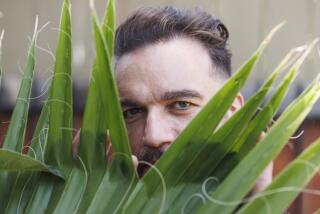Stone age meets the space age
- Share via
Artist Kenny Scharf’s hilltop garden in Culver City is no Monet masterpiece. It is more like a Georgia O’Keeffe -- rocks and concrete pavers set among colorful succulents and exotic cactuses that look like stones and desiccated brains. At one end of this primitive landscape, two sun-bleached imitation-Saarinen dinette chairs stand in a bed of gravel sprinkled with colored glass, beckoning visitors to sit and contemplate the 1988 Scharf bronze “Space Travel.”
The juxtaposition of “Jetsons”-style furniture and statuary in a “Flintstones” setting is particularly apt for Scharf. The 50-year-old painter and sculptor first shot to fame in the New York City street art scene of the 1980s with paintings that incorporated his favorite characters from those Hanna-Barbera cartoons. “Barberadise,” Scharf’s first Los Angeles-area show in four years, will continue this exploration of prehistoric and futuristic forms when it opens at Honor Fraser Gallery in Culver City today, running through Oct. 31.
In many ways, Scharf’s backyard is an ongoing art installation that incorporates found objects, salvaged plants and hand-painted planters perched on tree stumps. A casual observer might find that it looks rustic bordering on ramshackle. But the artist considers it a sculpture garden for his work, which includes the bronze water feature “Fountain of Life” and a stack of giant fiberglass “Madglad” teacups with grinning and snarling faces.
“At first, I thought my neighbor was a collector of 1950s Disneyland memorabilia,” says neighbor Chris Paine, director of “Who Killed the Electric Car?”
“When I found out it was Kenny’s own work, that made it even better,” he says, adding that he loves living next door to a place that celebrates art and witnessing “the crazy funky wonderful thing that Kenny does with everything he touches.”
Scharf says his low-water, minimal-maintenance planting scheme is a creative response to environmental concerns and his own itinerant lifestyle.
“I disconnected my sprinkler system years ago,” he says. “I’m against lawns in Los Angeles. I think they’re a waste of water. The whole idea of xeriscaping is that it can be left alone. This can pretty much survive on rainwater. As far as water-shortage doomsdays go, it will always be pretty up here.”
Inspired by the Desert Garden at the Huntington Botanical Gardens in San Marino, he replaced his lawn with gravel and created beds of golden barrel cactus, opuntia, organpipe cactus and succulents such as aeonium, echeveria and blue senecio. These plants, which he often grows from clippings or rescues from garbage bins, are more beautiful than garden-variety flowers, he says.
“A cactus often grows in a weird way that is individual and gives it personality,” Scharf says. “They do whatever they have to do to adapt and survive. Visually, they remind me of coral and the other-worldliness of undersea life.”
Scharf had purchased the property 10 years ago. The original owners, founders of the nearby Rolling Greens nursery, landscaped with a variety of drought-tolerant plants along with flowering agapanthus, hibiscus, ficus and a Brazilian floss silk tree. The front and side yards had gigantic stands of cactuses nearly half a century old, and the garden beds were decorated with rusty farm equipment and gold miners’ gear.
The ranch house with Alpine-influenced trim also mixed genres as freely as the artist does in his own work.
“What I love about Hollywood is that you can find western ranch and Swiss chalet architecture all mixed together in a 1959 tract home,” Scharf says. “Fantasy is allowed everywhere.”
For the most part, Scharf let it be. “I am interested in the relationship between the organic and the man-made,” he says. “Nature has a way of finding its own way into the cracks of a city and coexisting.”
As a source of inspiration, he adds, “Nature is so much crazier and more magical than any art can be.”
Still, Scharf has made practical improvements. He trimmed the lower branches of pine trees that circled the northern edge of the property, opening up a view of the ocean and the Santa Monica Mountains. He also let thirsty shrubs die, and he cut down ficus trees.
“I’ll see a tree that causes too much shade, drinks too much water and is overcrowding everything,” he says. “At the same time, it has gone to so much trouble to create a trunk and branches, I didn’t just want to eradicate it.”
The answer: Make the stumps pedestals. On some he attached epiphytes, more commonly known as air plants. On others he added plants in plain terra cotta containers splashed with his hand-painted tribal swirls.
He has also perched a potted ponytail palm in the middle of a live rosemary shrub, and in one exuberant example of his “organic, random and constantly changing” landscape design philosophy, he created the effect of a tree stump flowering by attaching old bottles, pots and broken crockery to it.
“It’s not like I consciously try to copy folk artists,” Scharf says. “But we have something in common: Don’t throw things away, use every knickknack for something, utilize the bits and pieces of your life and decorate with it.”
Adds Paine: “Kenny has a real eye for organic shapes and a respect for the way nature does things. He recognizes what is already there and puts his playful personality to it.”
As Scharf explains it, art and gardening are branches of creativity. “Growing things and making a painting are kind of a similar process. There is a combination of the planned and the improvised. Nature doesn’t need a lot of help from us. Things with shape and color and texture pop up in the garden and I let them. The fact that it’s alive is even more wonderful.”
The artist recognizes that to some observers his garden might be something of an unearthly delight. “Maybe it does look mutant compared to the average garden, like a monster that is let go on its own,” he concedes. “I don’t look at that as a bad thing.”






